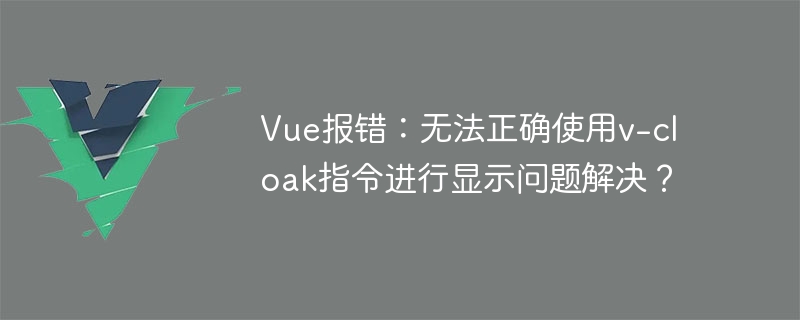Home >Web Front-end >Vue.js >Vue error: Unable to use v-cloak instruction correctly to solve the display problem?
Vue error: Unable to use v-cloak instruction correctly to solve the display problem?
- 王林Original
- 2023-08-25 20:52:572011browse

Vue error: Unable to use v-cloak instruction correctly to solve the display problem?
In recent years, with the rapid development of front-end technology, Vue.js, as a popular JavaScript framework, has been favored by more and more developers. In the process of building front-end applications with Vue.js, we may encounter various problems and errors. One of the common problems is that the v-cloak command cannot be displayed correctly. This article will detail this problem and provide a solution.
- Problem description
When we use the v-cloak directive in Vue.js, the purpose is to hide the Vue-bound elements before the page is loaded to avoid flickering during the initialization process. The problem. However, in some cases we may find that the v-cloak directive fails to take effect, i.e. the element is still visible during initialization. - Problem Analysis
To understand the cause of this problem, you first need to understand the compilation process of Vue.js. In Vue.js, when we use the {{}} syntax or the v-bind directive to bind data to a DOM element, Vue will compile and parse it before the element is loaded. During compilation, Vue scans the DOM tree and finds elements with specific Vue directives to process. The v-cloak instruction itself does not change the display mode of DOM elements. Instead, it uses CSS styles to control the display and hiding of elements after the Vue instance completes compilation and parsing. Therefore, if the v-cloak directive does not take effect, there may be a problem with loading CSS styles. - Solution
To solve this problem, we can try the following methods.
3.1 Ensure that CSS styles are loaded correctly
First, we need to ensure that CSS styles are loaded correctly before instantiating Vue. You can add a v-cloak style definition in the head tag, for example:
<style>
[v-cloak] {
display: none;
}
</style>This ensures that elements with v-cloak directives will be hidden until the Vue instance completes compilation and parsing.
3.2 Using dynamic binding
Vue.js also provides a dynamic binding method, which can ensure that the Vue instance is displayed only after it is loaded. You can dynamically bind the v-cloak attribute to an attribute in the Vue instance object through the v-bind instruction, for example:
<div v-cloak :class="{'v-cloak': isLoaded}">
<!-- Vue绑定的元素内容 -->
</div>In the data of the Vue instance, add an isLoaded attribute with an initial value of false . After the Vue instance is loaded, the element is displayed by modifying the value of the isLoaded attribute to true.
3.3 Use transition effects
If the above method still cannot solve the problem, we can try to use Vue's transition effect to display and hide elements. Vue.js provides a transition component that can add animation effects between showing and hiding elements. Elements with v-cloak instructions can be wrapped through the transition component, for example:
<transition name="fade">
<div v-cloak>
<!-- Vue绑定的元素内容 -->
</div>
</transition>At the same time, define the transition effect of .fade in the CSS style:
.fade-enter-active, .fade-leave-active {
transition: opacity 0.5s;
}
.fade-enter, .fade-leave-to {
opacity: 0;
}In this way, when the Vue instance is loaded Once you're done, use transition effects to control the showing and hiding of elements.
- Conclusion
When the v-cloak directive cannot be displayed correctly in Vue.js, we can ensure that the CSS style is loaded correctly, use dynamic binding, use transition effects, etc. to solve this problem. Depending on the specific scenario and needs, a suitable solution can be selected. These solutions can help us better use Vue.js and improve development efficiency.
I hope this article can help developers who encounter similar problems, allowing you to use the v-cloak command more easily and enjoy the convenience and fun brought by Vue.js!
The above is the detailed content of Vue error: Unable to use v-cloak instruction correctly to solve the display problem?. For more information, please follow other related articles on the PHP Chinese website!
Related articles
See more- Clicking the browser's back button will refresh the history page. Solution to this problem
- How to use v-cloak in vue to solve the problem of flashing when refreshing or loading
- How to solve the slide display problem on dedecms homepage
- Causes and solutions of database deadlocks
- What are the differences, advantages and disadvantages between react and vue

